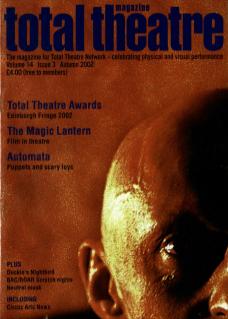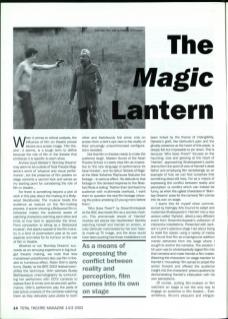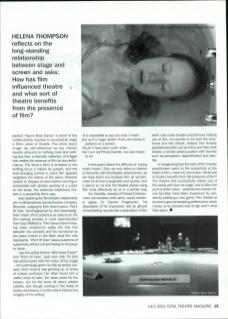When it comes to critical analysis, the influence of film on theatre proves elusive as a screen image. 'Film theatre', it seems, is a tough term to define because the role of film in the theatre that embraces it is specific to each show.
Andrew Lloyd Webber's Bombay Dreams may seem to be outside of Total Theatre Magazine's remit of ‘physical and visual performance', but the presence of film posters on stage warrants a second look and serves as my starting point for considering the role of film in theatre...
For there is something beyond a plot at work in this play about the making of a Bollywood blockbuster. The musical treats the audience as voyeurs on the film-making process. A scene showing a Bollywood film in rehearsal makes the audience aware of watching characters watching each other and hints at how best to appreciate the show. From conception to billing as a 'Bollywood musical', this playful expose of the film industry is a kind of postmodern joke at its own expense and relies for its humour on the use of film in theatre.
Whether or not Bombay Dreams succeeds as an amusing experiment in big-budget theatre-making, we note that less mainstream practitioners also use film in theatre to humorous effect. Robin Orlin's darkly funny Daddy at the BITE 2002 festival exemplifies the technique. Orlin satirises Busby Berkleyesque cinematography by surrounding her performers with CCTV cameras to expose their ill-timed and amateurish performance. Orlin's performers play the parts of bad actors unaware of the cameras watching them as they delicately pass plates to each other and fastidiously link arms: only on screen from a bird's eye view is the reality of their amusingly unsynchronised configurations revealed.
Not that film in theatre needs to make the audience laugh. Madani Younis of the Asian Theatre School in Leeds cites film as imperative to ‘the new language of performance for Asian theatre', and his debut Streets of Rage at the West Yorkshire Playhouse features live footage – to serious effect. His attitude to that footage in this devised response to the Bradford Riots is telling: 'Rather than bombard my audience with multimedia overload, I want them to question the real film footage [showing the police arresting 23 young men] before them.'
As a means of expressing the conflict between reality and perception, film comes into its own on stage.
Who Goes There? by Dreamthinkspeak at BAC also treats film as a sombre medium. This promenade rework of Hamlet involves set pieces like heartbroken Ophelia watching herself and Hamlet on screen, or lusty Gertrude mesmerised by her own heavily made-up TV image, and the show would have been puzzling had these installations not been linked by the theme of intangibility. Ophelia's grief, like Gertrude's pain and the ghostly presence at the heart of this piece, is deeply felt but impossible to pin down. This is because Who Goes There? focuses on the haunting, loss and grieving at the heart of Hamlet, approaching Shakespeare's poetic drama from the point of view of Hamlet's dead father and employing film tantalisingly as an example of how we can fool ourselves that something dead still lives. For as a means of expressing the conflict between reality and perception (a conflict which can indeed be funny, as when the ugliest characters in Bombay Dreams pose for the camera) film comes into its own on stage.
I learnt this for myself when commissioned by Haringey Arts Council to adapt and modernise Shakespeare's Hamlet into a new version called Ophelia, albeit a very different event from Dreamthinkspeak's collection of interactive installations. Presented with Jacksons Lane's spacious stage I set about trying to retell the classic using a variety of media and found that film as a background addition merely detracted from the stage where I sought to anchor the narrative. The solution I hit upon was to wholeheartedly digest film into that narrative and make Hamlet a film-maker. Watching the characters' on-stage reaction to Hamlet's 'mousetrap' film served to propel the action forward and offered the audience insight into the characters' preoccupations by demonstrating Hamlet's infatuation with his own perceptions.
Of course, putting film-makers or film watchers on stage is not the only way to engage an audience in film theatre... Ever ambitious, Shunt's eloquent and intrigue-packed Dance Bear Dance is proof of the craftsmanship required to successfully stage a filmic piece of theatre. This show about image (as self-referential as any Hamlet rework) amounts to nothing more and nothing less than a dramatic collection of images that realise the essence of film as live performance. The show's form is imitative of the shifting focus it makes its subject, and the ever-changing context in which film appears heightens the drama of the piece. Whether treated to displays of slow-motion burning or bombarded with photos warning of a culprit on the loose, the audience experience theatre in a powerfully filmic way.
Also exploring the film/theatre relationship are multidisciplinary dance-theatre company, Ricochet. Judging by their recent piece, Point Of View (choreographed by Neil Greenberg), their notion of the audience as voyeurs on the film-making process is more sophisticated than Lloyd Webber's. Their dance piece involving video projections walks the fine line between the cerebral and the emotional as the piece enacts in the flesh what film only represents. Point Of View raises questions of subjectivity without compromising on its power to move.
Like the artists behind Who Goes There? and Point Of View, poet and critic TS Eliot was preoccupied with the notion of the image – not surprisingly given his role as artistic pioneer when cinema was growing up. In times of critical confusion I've often found him a useful voice of calm. He never wrote for the screen, but he did know all about artistic hybrids, and though working in the fields of poetry and drama, it is film which informs the imagery of his writing:
'It is impossible to say just what I mean!
But as if a magic lantern threw the nerves in patterns on a screen:
Would it have been worth while...
No! I am not Prince Hamlet, nor was meant to be.’
In this poem about the difficulty of ‘saying what I mean', Eliot not only refers to Hamlet (a favourite with film-theatre practitioners, as we have seen) but employs film as symptomatic of all that is enigmatic and elusive. And it seems to me that the theatre pieces using film most effectively do so in a similar way.
Tim Etchells, director of Forced Entertainment and another critic-artist, would certainly agree. In Certain Fragments, his description of his characters' text as 'ghosts of real feeling’ sounds like a description of film itself. Like many theatre practitioners making use of film, his concern is for both the emotional and the critical. Indeed, film theatre practitioners often act as critics and their work shares a similar preoccupation with themes such as perception, objectification and identity.
In recognising that the best of film theatre practitioners warm to the subjectivity at the heart of film, I have my conclusion: What sort of theatre benefits from the presence of film? The theatre that successfully makes use of film deals with how we judge, and is often the stuff of artist-critics-practitioners whose critical faculties have been sharpened by constantly justifying a new genre. Film theatre at its best is ground-breaking performance which moves us to perceive that things aren't what they seem.


